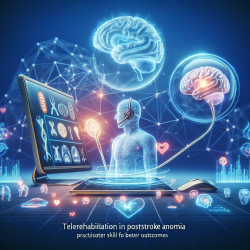As speech-language pathologists (SLPs), we constantly seek effective and innovative ways to support our clients. The study "Telerehabilitation in Poststroke Anomia" offers valuable insights into the feasibility and effectiveness of remote therapy for patients with poststroke anomia. By understanding and implementing these findings, practitioners can enhance their skills and potentially improve patient outcomes.
Key Findings from the Study
The research, conducted by Agostini et al. (2014), explored the feasibility of telerehabilitation compared to conventional face-to-face treatment for patients with poststroke anomia. The study involved five chronic aphasic patients who participated in both face-to-face and remote therapy sessions. The primary outcome measure was naming accuracy, assessed at three time points: baseline, immediately after treatment, and three weeks post-treatment.
Key findings include:
- No significant difference in treatment efficacy between face-to-face and remote therapy (P = 0.844).
- Significant improvement in naming accuracy immediately after treatment and at follow-up compared to baseline (P = 0.0004).
- Comparable results in both treatment modalities, suggesting that remote therapy is as effective as conventional methods.
Implications for Practice
These findings have several implications for SLPs:
- Accessibility: Telerehabilitation can overcome geographical barriers, providing access to therapy for patients in remote or underserved areas.
- Cost-Effectiveness: Remote therapy can reduce costs associated with travel and in-person sessions, making it a viable option for long-term rehabilitation.
- Continuity of Care: Telerehabilitation ensures continuous support, which is crucial for the steady progress required in poststroke rehabilitation.
Encouraging Further Research
While the study provides promising results, further research is necessary to explore the long-term effects and potential of telerehabilitation for other language components such as phonology, semantics, and syntax. Practitioners are encouraged to contribute to this growing field by conducting and participating in additional studies.
Conclusion
The study by Agostini et al. highlights the feasibility and effectiveness of telerehabilitation for poststroke anomia. By integrating these findings into practice, SLPs can enhance their service delivery, ensuring better outcomes for their patients. To read the original research paper, please follow this link: Telerehabilitation in Poststroke Anomia.










